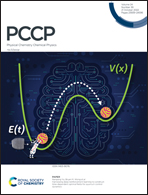Electron–phonon interaction effect on the photovoltaic parameters of indirect (direct) bandgap AlSb (GaSb) p–n junction solar cell devices: a density functional theoretical study†
Abstract
Semiconductors AlSb and GaSb have emerged, in recent years, as important candidates for photovoltaic applications due to their strong absorption coefficients and other photovoltaic properties. In this study, AlSb (GaSb) p–n junction-based solar cell device parameters and properties are studied using the density functional theoretical framework and the non-equilibrium Green function approach. The effect of temperature on various solar cell parameters such as open-circuit voltage, power conversion efficiency, photocurrent density, short-circuit current, etc. is investigated using a special-thermal-displacement approach along with the GGA-1/2 exchange–correlation functional. As temperature increases, the phonons are found to significantly influence the charge carrier transport in the solar cells. The computed power conversion efficiencies for AlSb are estimated as 12.31% and 10.21% at 0 K and 400 K, respectively. The obtained results strongly indicate that the electron–phonon coupling and resulting phonon-assisted photon absorption are necessary for accurate description and prediction of solar cell properties. The estimates obtained in this study may serve as first-principles parameters with possible use in continuum model-based multiscale simulations of AlSb (GaSb) p–n homo-junction solar cells.



 Please wait while we load your content...
Please wait while we load your content...